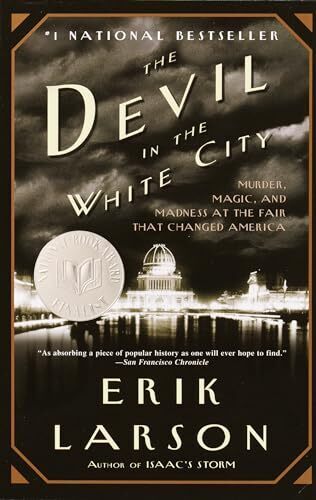
The good
-
An interesting look at the Chicago World’s Fair (AKA World’s Columbian Exposition) from 1893, where they managed to assemble some astonishing architecture in just a couple of years (check out the photos on Wikipedia!), lots of amazing performances (including Harry Houdini and Buffalo Bill), and where the world saw, for the first time, the Ferris Wheel, electric lighting and AC power at massive scale, the zipper, Shredded Wheat, the electric car, and many other new inventions. The book does a good job of getting you into the mindset of that era, at the height of industrialism and national pride, when world fairs were a way for countries to compete with each other (e.g., the whole world was jealous of France’s world fair, where they revealed the Eiffel Tower, which was the tallest structure in the world at the time).
-
A creepy look at one of the world’s first serial killers, H. H. Holmes, who killed dozens, perhaps even hundreds of people, while living in Chicago; he even built a hotel (“the murder castle”) dedicated to these murders, complete with hidden rooms, soundproofing, acid vats, and a crematorium. In this era, when the terms serial killer and psycho had not yet entered the public consciousness, people simply couldn’t imagine someone like Holmes killing people, especially with no clear motivation. He got away with so much—not just murder, but also lots of cons and fraud—just because he was a doctor, charming, good-looking, and appeared wealthy. The book roughly defines a psychopath as someone who is merely pretending to be human; it was indeed disturbing to read about the way Holmes manipulated people, tortured people, killed people, and seemed to feel no remorse or empathy of any kind.
-
The two stories are reasonably well written. Although technically non-fiction, the book focuses on people, includes dialog, even the write-up of some of the gruesome murders, with plenty of dramatic flair, so this isn’t a dry history book.
The not so good
-
Although H. H. Holmes did live in Chicago, and killed some people during the world’s fair, the connection is pretty tenuous (e.g., Holmes lived and killed in other places too), and it feels like you’re reading two separate books that have been glued together. There are also some random pieces thrown in, such as the murder of the mayor Chicago, that were loosely related, but didn’t add much to the story.
-
The book seems thoroughly researched, but at the end, Larson admits that many of the parts about Holmes are speculation or completely made up. The reality is that we know relatively little about Holmes—after being caught, he confessed 3 times, but all 3 are different, and provably full of lies—so this isn’t pure non-fiction either.
